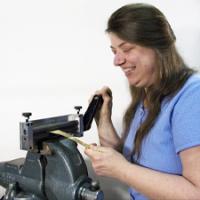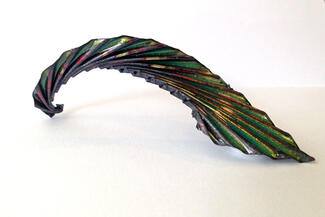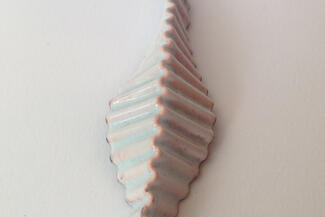Microfolding and Enamel: Color and Form
In this exciting class, students will work with two interesting metalworking processes that are ideal for bringing together lightweight form, rich textures, and the beauty of vitreous enamel color. Both microfolding and enameling offer endless possibilities for creative expression. The characteristic undulating surface that results from microfolding, a type of corrugation, adds strength to thin metal, making it possible to create large, yet light and sturdy forms. In this new weekly course, students will learn how to enamel on these textured forms, further adding to their expressive qualities.
This course is being co-taught between two renowned artist-instructors who will take turns teaching and being the student of the respective techniques in this class. Each demonstration will be followed by work time. Have fun learning alongside them! Cynthia Eid will demonstrate a variety of microfolding techniques, including fanfolds and ribbon forms, smocking, fold forming, and making microfolded beads. Barbara Seidenath will teach the enameling section in which you will learn how to apply enamel to 3-D forms created in Cynthia’s classes, using powdered and liquid enamels. A variety of sifting and painting techniques will be demonstrated. Soldering, welding and construction of hollow forms suited for enameling will be covered as well as the application of findings and settings to finalize your pieces.
Process, technique, and design are emphasized in this class, rather than being project-oriented. Participants will learn techniques by means of making samples with the goal of one finished piece by the end of the class. This course is designed for advanced students and professionals. Pre-requisite are basic skills of enameling and Jewelry 1.
Meet the instructor

Whether using hammers and stakes, or hydraulic press tools, Cynthia's sculptural jewelry and hollowware shows her focus on exploring the fluidity with which metal can be moved, formed, and joined.
Cynthia Eid co-authored the book Creative Metal Forming, with Betty Helen Longhi, published in 2013 by Tim McCreight's Brynmorgen Press. In his foreword for the book, Michael Good says the authors "have succeeded in assembling the first comprehensive textbook on synclastic and anticlastic forming." (More about the book available at www.creativemetalforming.com.)
Cynthia and Betty developed a set of anticlastic stakes, and Eid also works with Knew Concepts and Bonny Doon to help make tools for jewelers and metalsmiths. Lee Marshall has dubbed Cynthia Eid "Godmother of the Knew Concept Saws" since it was her idea for him to produce these saws for jewelers.
Excited about working in sterling silver without the problem of firescale, Cynthia has been working with Argentium Silver since 1999. After meeting Peter Johns (the inventor of Argentium Silver) in 2003, Eid has participated in AS's development. Argentium International, Ltd recognizes her as a Pioneer.
Cynthia Eid's metalwork has won awards for creativity and design, been featured in many publications, and been exhibited internationally. With a BS in Art Education and MFA in Jewelry, Design, and Silversmithing, she has previously worked as a bench jeweler for fine goldsmiths, a model-maker in a gold jewelry factory, and on private commissions. Her work is in museums in the US and UK. Currently an independent metalsmith and educator, she teaches weekly classes at Metalwerx in Massachusetts, and workshops and short courses in the US, Canada, Europe, and Australia.
Materials & Tools
There is a $50 materials fee for this course, which is payable upon registration, and includes copper sheet metal in 24, 28 adn 34 gauge, IT solder appropriate for enameling, and the use of all enamels and various supplies necessary to complete the processes covered in the course.
- saw blades
- pen/pencil and a notebook
- opening tools for fold forms, such as a straight burnisher, old butter knife, old letter opener, wooden clay tools….
- apron
- camera
- small boxes and/or baggies for taking care of materials, samples, and projects
- 1 or more clean “shop cloths”, such as an old towel, (to save on paper towels)
OPTIONAL:
- If you tend to work prolifically, or like to work large, you may wish to bring additional metal.
- Copper will be supplied in materials kits, but students can use Argentium Silver, traditional Sterling, or Fine Silver, in 34 to 24 gauge
- Wire and findings can be nice to have for finishing work.
Metalwerx has all of these tools, however, students are encourage to bring any of the following tools that they already own:
- Microfold brake or corrugation tools
- Confirming pliers
- Safety glasses
- respirator
- wire cutter
- optivisor or clip-on magnifier
- scissors
- ruler
- pliers, such as fine-tipped chain nose, round nose, flat pliers, half-round/flat
- jeweler's saw
- favorite flex shaft tools, especially rubber abrasives and radial bristle discs
- favorite solder and soldering tools (eg. soldering poker, tweezers, flux brush …)
- dividers
- scribe
- steel bench block
- dapping block
- metal shears (Hand-held)—instructor recommends Joyce Chen shears, available from Allcraft (call 1-800-645-7124. Ask for Tevel, and tell him you are a student of Cynthia Eid.) A sturdy pair of scissors can work just fine, since all the metal will be 24 gauge or thinner.
- files, such as a #2 cut half-round file
- abrasive paper, sanding sticks



